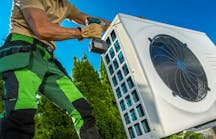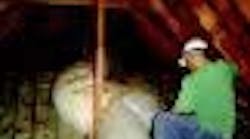By Steve Saunders
Jay Copeland prepares for a building tightness (blower door-building envelope infiltration) test.
Our potential customers are bombarded with many offers of energy savings — especially now, with energy costs rising as steeply as they are. Without careful positioning, it's very easy for us to get caught up in a race to promise more savings than we can deliver. Most of these energy-saving claims have some documentary support, but homeowners can be — and often are — easily misled about the true savings potential. Offering home performance as part of your business is not only practical, it's a smart business decision that will boost your credibility and help you guide those misled homeowners to the right solution for their problems.
At Tempo Mechanical, we've been primarily an HVAC contractor specializing in single-family homes. As a relatively large new-construction contractor, we installed air conditioning systems in about 4,500 new homes last year. This year, we will answer about 25,000 service calls of all types. To do this much work in homes, we have to know a lot about how homes perform, and we also know a good business opportunity when we see one.
Incorporating Home Performance Into Your Business
Last spring, after two years of consideration, we finally got serious about offering home performance. It made a lot of strategic sense for us to pursue this type of business, and we're glad we did. Our first year of revenue, from inception, is just short of $400,000. The numbers are rapidly rising and we believe we're only scratching the surface of this business opportunity.
Home performance contracting is very similar to high-level HVAC service contracting. They both focus on the same business and building envelope issues, each one sees the home's envelope as a key determinant of how to proceed, and — at least in Texas — much of the home performance and energy improvement opportunities tie right back to improvements in the HVAC system.
We struggled to decide what business unit and brand identity we would use in our home performance business. Would it be Tempo, or would it be our energy code inspections company, Tex-Energy? We decided to offer home performance services through TexEnergy, because TexEnergy would be the best brand to target our likely home performance customers.
These home performance customers live in homes that are worth more that $125,000 and are more than 15 years old. They have high utility bills, or comfort or air quality problem large enough that they are willing to seek assistance; and they have the financial means to solve the problem.
To truly evaluate the homeowner's problems, and tailor a specific home performance solution for them, we developed a core offering that is based on a diagnostic analysis of the home — a home energy audit.
Tailor Your Energy Audits
Our comprehensive energy audit only costs the customer $500; and since the audit we perform is so comprehensive, that $500 doesn't come close to covering all of our costs.
Our complete audit process includes duct blaster and blower door tests, a check for leaks with smoke pencils, and often we monitor the home for humidity, carbon dioxide, carbon monoxide, and airborne particles using an indoor air quality monitor. It usually takes two energy technicians three to four hours each to perform this initial phase of the audit.
Next, we'll send an analyst to capture the air conditioning load, the HVAC layout, and the window schedule and floor plan. The analyst identifies comfort problems, probes for healthy home and indoor air quality issues, and then answers questions and summarizes data.
It takes anywhere from three to five days to complete this analysis and prepare recommendations for the homeowner. Our proposal includes a lot of general and specific information, and the summary data is simple and clear — easily read and understood by any customer.
Homeowners who pay $500 for an audit believe they have a problem. Their struggle is to find a company that has a solution for their particular problems, rather than a company that will try to fit a prepackaged solution to their problems.
We invest this substantial amount of time and expertise in each audit so that we'll know how best to help a particular home. Because our audits are real, because they are extensive, and because a huge part of the home performance process is credibility, the number of homeownerswho accept our recommendations is very high.
Know Your Limitations
Unlikely customers for home performance are those who live in newly constructed homes — homes that are very tight, highly energy efficient, and generally well designed. In Texas, the land of new construction, an ancient home is one that was built in the 1920s or 1930s. In this territory, the vast majority of all homes have been built since 1955.
The big opportunities for energy improvement come mostly from insulation, HVAC and duct leakage, window replacement, and infiltration. Since we don't do windows, that leaves us with fewer homes that offer big opportunities. Instead of learning about this field, our strategy was to find and develop partners that can help us with what we don't do well.
Our goal is to help them in the areas where our superior knowledge and expertise might support their business efforts. In general, we share leads and sell each other's work. We buy wholesalepriced services from our installation partners and sell them at retail prices to our customers.
We provide our partners with a sold customer, a clear scope of work, job scheduling and coordination, and no collection problems, and they do the same for us. It's a solid strategy that has enabled us to expand and market our home performance business.
It's an ongoing challenge to make a home performance business valuable to homeowners, as well as employees. We have made significant strides in becoming a company that delivers tailored solutions and in developing home performance as a viable business. With the recent dramatic price increases in electricity and natural gas, the home performance market should continue to grow rapidly.









